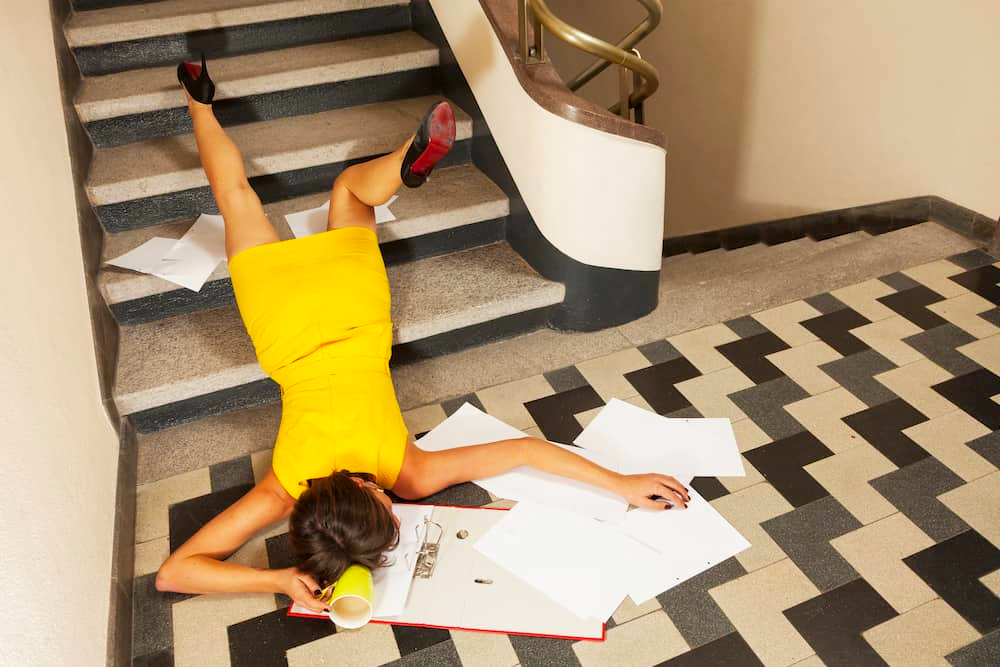It’s February and this means it is time to reflect on the loves of our lives and celebrate the Valentine’s in our lives. Unlike falling in love, falling (and the things we do to avoid falling) can wreak havoc on our lives as adults.
Have you ever jarred your back because you were trying to avoid a fall? Sometimes this can cause problems even if we were successful at catching ourselves. In this article, we will learn more about falls. What puts us at risk for falling and how to avoid them in the first place.
Falls are considered a risk for bone breaks and are likely to lead to more serious problems such as a trip to the hospital. Older adults fear falls as they often result in serious injuries that lead to chronic pain. According to the National Institute on Aging, Scientists have linked several personal risk factors to falling, including muscle weakness, problems with balance and gait, and blood pressure that drops too much when you get up from lying down or sitting (called postural hypotension), and even an UTI can lead to a fall, in fact, the first thing most doctors look at, after a fall, is the possibility of an undiagnosed UTI.
There are too many stories where a person is lying on the floor for hours as they live alone and unable to get up or call emergency services. Having the tools to recover from a fall or even better, avoid a fall can literally mean the difference between life or death. Continue reading to learn more about avoiding those nasty falls and some helpful tools for fall recovery.
Top 8 Tips to Avoid Injuries Due to Falling:
- Stay Active
- Minimize obstacles
- Eliminate Distractions
- Get Plenty of Rest When You Are Sick
- Improve Flexibility
- Seek out physical therapy
- Wear orthotics and shoes that fit
- Fall correctly and get back up carefully
Stay Active
The best way to prevent falls is to stay active and keep muscles and joints moving. A body in motion stays in motion. A huge reason behind falls among older people is the fact that they slow down and become less active. Those with active jobs who eventually retire may withdraw from activities they used to perform simply because they are not required to work anymore. It is important to remain active especially when it comes to hips and ankles. It is especially important to strengthen Hips and Ankles.
Minimize Obstacles
Use nightlights to light the way and get rid of items that may cause you to trip. Keeping the pathways in your home clear of clothing, kids toys, and liquid spills will minimize your risk of falls. Because balance is compromised in low light, use night lights to guide pathways. Also, a smart phone with a flashlight feature is also useful at night.
Eliminate Distractions
Talking or texting on the phone can be a distraction. Many phone users are caught off guard while using these devices. You wouldn’t text or talk on the phone while driving. The same rule applies while walking. In addition, having something in your hands makes you less able to catch yourself if you do happen to trip or land on your feet in “the wrong way”. It happens to the best of us.
Get Plenty of Rest
Fatigue causes instability issues. When you are sick or tired, muscles are less able to keep you balanced. Rest until you are more alert. It’s best to get plenty of rest, especially when you are sick. Reach out to the proper medical professionals if you are not feeling well and stay healthy.
Seek Out Medical Assistance
If you are experiencing health issues such as stress, vision or hearing loss as these can lead to falls. Your overall health is a concern when preventing falls. Physical, emotional stress and even a UTI can lead to a fall. It’s best to get plenty of rest, especially when you are sick. Reach out to the proper medical professionals if you are not feeling well and stay healthy.
Improve Flexibility
Physical therapy, such as manual therapy, that focuses on increasing flexibility in the body can be helpful in preventing falls. Flexibility, especially in the ankles is important because they are the first to be recruited for balance. This can be affected if you have stiff ankles, tightness or pain in the ankle or knee joint.
Why the knee? Because certain muscles begin at the knee and end at the foot! The muscle imbalance caused by an injury or pain impedes how quickly you can react to a loss of balance. This is when the ankle is working to prevent you from falling.
Wear Orthotics and Shoes That Fit
Many factors can lead to tight and weak ankles such as injuries, incorrect footwear or sedentary lifestyle. Custom orthotics improve balance within the body and cushion joints making the wearer less likely to fall. Wearing stable shoes such as tennis shoes or sandals with back straps should be paired with the proper orthotics. Our office even offers flip flops with built in orthotics. Orthotics will prevent your arch of foot from being flat and will allow you to initiate the walking pattern appropriately with less compensations and decrease the risk of tripping and slipping.
As we live in Florida, we understand how difficult wearing a tennis shoe can be with this hot weather! However, wearing a shoe without back support such as a sandal alters your gait pattern leading to muscle imbalance between your ankle and knee joint as mentioned above. This is because in order for you not to lose the sandal, you need to crunch your toes or some other compensation that affects landing on your heel. Landing on the heel is the first step in correct walking, hence if you cannot do this, the rest of the walking pattern is affected.
Overall, sandals are just more risky in Florida as they tend to ‘get caught’ affecting your foot clearance and possibility of you tripping. Not to mention in the rainy season, slips and falls are more likely. When you can’t prevent a fall, it is helpful to learn the best ways to fall.
Avoid Fall Related Injury:
- How To Fall Correctly
- Try Not to Tense-up
- Get Back Up Carefully
How to Fall Correctly
Although the elderly are at an increased rate of falling, anyone is at risk of falling or having a near fall. A near fall is when you trip, stumble but are able to catch yourself; healthcare professionals count this as a fall. Falls happen very quickly and many people, when asked, say they are not sure what happened.
Try Not to Tense-up
Once you know you are falling, just try to relax your body instead of tensing up; if you do tense up, more muscles will become tight and lead to pain over time. Falling correctly seems counterintuitive since the reflex is to catch ourselves. Yet, studies have shown that people are less likely to break a bone if they go with the flow (while doing their best to protect the head.) Should you happen to fall, don’t rush to get up right away. Allow yourself to catch your breath, then assess for injuries.
Get Back Up Carefully
Getting up from a fall is a great skill that, when done correctly, will prevent further injury whether you have had a fall from some height, experienced a jolt, or “near fall.” In addition, it will increase your chances of being able to get up successfully.
Overall, it’s best to avoid falls… Other than falling in love. I hope you have enjoyed these tips and feel more confident in your ability to avoid fall risk. To learn more, please check out our newsletter. Sign up here. Patient education is the number one way to avoid unnecessary injury during and after a fall. Muscle weakness, problems with balance and gait, and blood pressure that drops too much when you get up from lying down or sitting(called postural hypotension).


